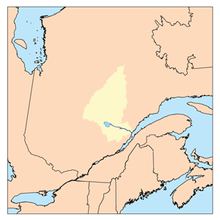| Maskoskanaw | |
|---|---|
 Watershed of Saguenay River | |
| Location | |
| Country | Canada |
| Province | Quebec |
| Region | Saguenay-Lac-Saint-Jean |
| Physical characteristics | |
| Source | Malsain Lake |
| • location | Lac-Ashuapmushuan, Quebec, Le Domaine-du-Roy (RCM), Saguenay-Lac-Saint-Jean, Quebec |
| • coordinates | 48°51′21″N 74°11′22″W / 48.85583°N 74.18944°W |
| • elevation | 460 m (1,510 ft) |
| Mouth | Frontenac Lake (Milieu River) |
• location | Lac-Ashuapmushuan, Quebec, Le Domaine-du-Roy (RCM), Saguenay-Lac-Saint-Jean, Quebec |
• coordinates | 48°56′33″N 74°06′18″W / 48.94250°N 74.10500°W |
• elevation | 427 m (1,401 ft) |
| Length | 24.4 km (15.2 mi)[1] |
| Basin features | |
| Tributaries | |
| • left |
|
| • right |
|
Maskoskanaw River is a tributary of Frontenac Lake (Milieu River), flowing into the unorganized territory of Lac-Ashuapmushuan, Quebec, in the Regional County Municipality (MRC) of Le Domaine-du-Roy, in the administrative region of Saguenay-Lac-Saint-Jean, in Quebec, in Canada.
The Maskoskanaw River flows successively into the townships of Huard and Buade. Forestry is the main economic activity of this valley; recreational tourism activities, second.
The forest road R0212 (East-West direction) cuts the middle of the course of the Milieu River (Normandin River). The route 451 linking La Tuque to Obedjiwan, Quebec passes south of Patterson Lake; several secondary road branches serving the surroundings of this head lake.
The surface of the Maskoskanaw River is usually frozen from early November to mid-May, however, safe ice movement is generally from mid-November to mid-April.
- ^ "Atlas of Canada". atlas.nrcan.gc.ca. Retrieved 2018-02-13.